In the world of bespoke fashion and design, few Australians occupy the echelon in which you’ll find Gwendolynne Burkin. Over 27 years since launching her eponymous label, Burkin has become world-renowned for her bridal and evening gowns, which centre around her signature fine-needle beadwork.
Even with the assistance of computer programs such as Adobe Illustrator, each pattern can take Burkin years to perfect. So when the self-described “fashion purist” relays the joy she is experiencing from dabbling in AI to help solve beading’s more befuddling puzzles, I am a little surprised.
She explains: “Because I am so small, I have had to be smart all along … [and] adapt to the new way of doing things,” she says. “The garments themselves have to be handcrafted, so I have to find some [efficiencies] in other ways.”
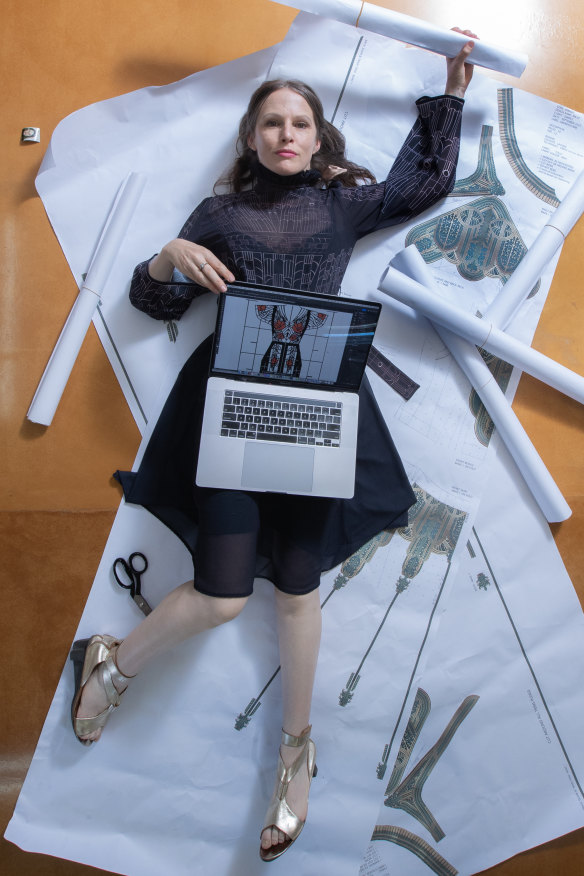
“I have had to adapt to the new way of doing things,” says Gwendolynne Burkin.Credit: Simon Schluter
Technology isn’t new to Burkin’s practice; she employs digital tools to resize her patterns, meaning she can create hand-beaded gowns for women sized 4 to 28 that flatter the body – something she assures me is a rarity in the couture world. “It would simply not be feasible to be hand drawn every time,” she says. “Plus, working like this is more sustainable and less wastage.”
Indeed, technology’s use in fashion spans the very practical to the fantastical. Burkin has also played with AI to create virtual worlds in which she can show models – rendered as avatars – wearing her gowns in 3D, accompanied by her poetry or other writing.
“In the visual space, it allows me to draw into my ethereal, magical and esoteric themes,” she says. “It allows my audience to be immersed in the depths of my imagination and transcend reality.”
Burkin, like many of her peers in the fashion community, is standing at a fork in the road between tradition – the “dying” arts of pattern making, drafting, draping, and so on – and technology, the most prevalent (and controversial) example of which is the use of AI in the creation of physical garments.
Designer Bianca Spender, known for her signature draping techniques, believes strongly in technology’s potential to unlock complex issues around sustainability. But when it comes to design, she’s more hesitant. “I can always see a marriage of these worlds, but it has to start with the hand touch,” she says.
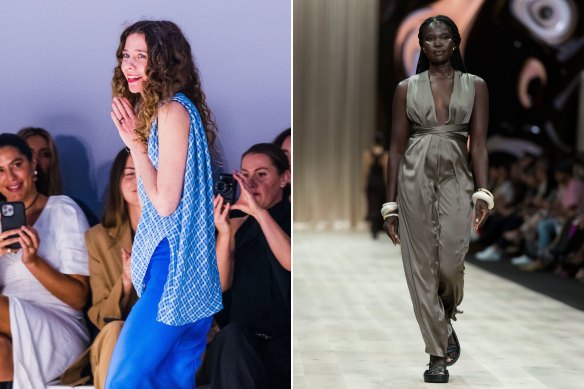
Bianca Spender (left), and one of her draped designs on the runway.Credit: Getty
Spender begins most designs by “diagnosing” a fabric: its pliability, how it might accentuate the female form. She wonders, could a machine ever replicate that? “I want to feel the air between the garment and body – that is a very ‘felt’ sense that is really in the hands and body, it’s intuition rather than a thought process,” she says.
Technology has been at the forefront of fashion for centuries, since the invention of the spinning wheel, then sewing and knitting machines during the Industrial Revolution, to graphic-design programs and even robots. Still, there is something about this period in history that epitomises the tension between innovation and tradition in fashion, says Katie Somerville, the National Gallery of Victoria’s senior curator of fashion and textiles.
There’s quite a strong fear-driven narrative that unless you get on board or ahead of the curve, you will be replaced.
Katie Somerville, NGV senior curator of fashion and textiles
“Audiences … are still spellbound and compelled to know about things from their handmade quality. How many hours, how many thousand beads,” she says.
Of course, that creativity can extend to the virtual world, but it’s up to professionals like Somerville and, ultimately, consumers to assess what technology is adding to the art form of fashion, and what is just gimmickry. “People want something genuine, they want to hear the designer speak about the process, what technique they developed,” she says. “If it’s purely in the realm of AI, you lose the steps along the way.”
Even so, Somerville cautions against a doomsday narrative around the ethics and application of technology in the arts, be it fashion, music, or the fine arts. “There’s quite a strong fear-driven narrative that unless you get on board or ahead of the curve, you will be replaced,” she says. “But I think that’s a bit black and white.”
Still, one need only look at the latest Census data to confirm certain people’s worst fears. Over the past 18 years, the number of pattern makers in Australia has fallen from 757 to just 341. How – and what – fashion students learn will drastically alter what kind of fashion industry Australia has by the end of this century.
“[Thirty] years ago, they would have been able to execute every aspect of designing – sketching, [making toiles], cutting, modelling on mannequin, grading – now it feels like some of those aspects of their education are no longer getting the teaching hours,” Somerville says.
Still, not every young designer fits the archetype of a digital native who can’t cut a pattern or sew. Among the champions of traditional techniques is Par Moi designer Ashiya Omundsen, whose Brunswick apartment doubles as her studio.
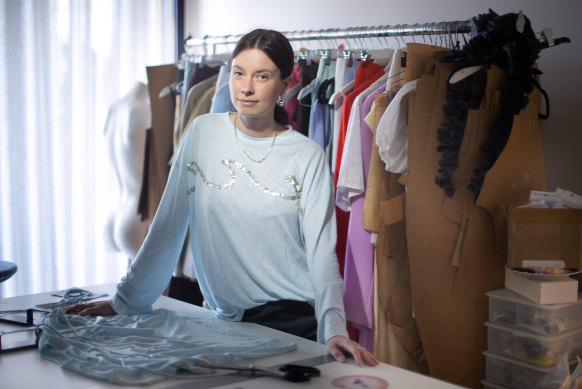
Committed to handmade … Par Moi’s Ashiya Omundsen in her Brunswick home studio.Credit: Simon Schluter
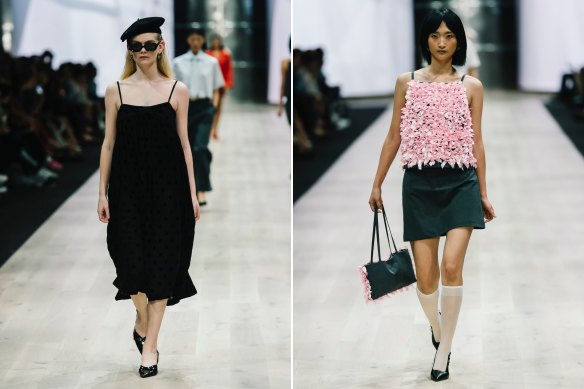
Par Moi designs at the 2024 Melbourne Fashion Festival.Credit: Getty
Handmade to order, Par Moi is the epitome of slow fashion, something that’s becoming less viable in this economic climate, even based on the number of small businesses that have closed in the past year. “I do everything myself. It’s all done here, no seasons, mostly direct to customer, so not really focusing on wholesale at all,” she says.
Par Moi’s range of girly dresses that are sexy but not “on trend” epitomises the choice young consumers have between accessible, yet homogenous, fast fashion, and something more considered. “My customer is someone who is very considered about the process … that it’s made [locally] and by someone … accessible,” she says.
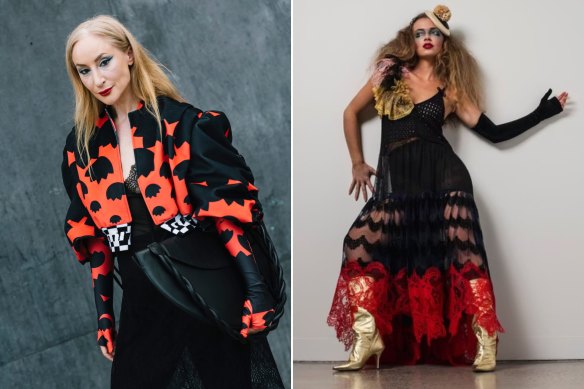
Saint Stella M designer Estelle Michaelides (left) and one of her designs.Credit: Getty/Megan Harding
In her book Wear Next, writer Clare Press imagines a fashion industry that has solved its most pressing issues, including the treatment of garment workers and sustainability. On technology, she writes in the book’s introduction: “Slow, local fashion is flourishing. But if you prefer, there’s a high-tech digital solution for everything.”
But maybe not just anything. Most of the designers interviewed for this piece raised the “too perfect” nature of AI, or its tendency to overthink and over-embellish. Spender points to the Japanese philosophy of kintsugi, which celebrates imperfections. And Estelle Michaelides, of Saint Stella M, is comfortable creating designs and content for the metaverse, but resists folding AI into her physical process. “It’s poetic and beautiful to be in a trade and in a craft – and it’s dying,” she says. “I wouldn’t dare consider illustrating on [a computer] – that’s not even an option.”
One “classical” designer who has seemingly found the sweet spot is Dutch innovator Iris van Herpen, whose work incorporates 3D printing and AI. For her, collaborating with architects, scientists and engineers helped “build a bridge” between worlds, and unlocked technologies once considered anathema to the couture discipline.
Van Herpen, who visited Australia in July to launch a retrospective of her work at the Queensland Gallery of Modern Art, says she values technology as a tool, but not as a goal unto itself.
“The most important lesson I’ve learned through experimenting with AI … is actually that my imagination and my creative process is the most precious thing that I have,” she says. “AI is very important within society to bring solutions for some of the most precious issues that are going on, but it’s not necessarily needed to involve in a creative process.”
Gwendolynne, Par Moi, Saint Stella M and Bianca Spender will all feature on runways at Melbourne Fashion Week, October 21-27. mfw.melbourne.vic.gov.au


